If you enjoy Bass fishing in spectacular scenery, North Carolina should be on your bucket list. From the misty mountains in the west, through the Piedmont region in the center, all the way to the coastal plains in the far east, the Tar Heel State has great Bass fishing in a variety of habitats.

In this article, I’m going to dive deep into Bass fishing in North Carolina, including where to go, popular techniques, and other information. By the time you’re done reading, you’ll be ready to plan your Bass fishing trip. Let’s dive in!
Smallmouth vs. Largemouth: Where?
First things first. Which Bass can you catch in North Carolina? While we’ll get to some of the rarer Bass creatures in a bit, here, we’ll focus on the most popular Black Bass you can find. Indeed, North Carolina is home to both Smallmouth Bass and Largemouth Bass. And, although most Bass anglers fall into one camp or the other, this means more opportunity for everyone.

Smallmouth Bass are more common in the cool and swift streams in the western part of the state. Both conventional anglers and fly fishermen pursue “bronze backs,” often in breathtaking settings.
Meanwhile, Largemouth Bass are common throughout the entire state. But you’re more likely to find them in lakes, ponds, and reservoirs in the Piedmont region and eastern lowlands.
However, if you’re lucky, you can find yourself on a waterbody that supports healthy populations of both fish! But more on that later on.
Other Bass Species in North Carolina
Aside from the popular Largemouth and Smallmouth populations, North Carolina is also home to a healthy population of Spotted Bass and Striped Bass.

Spotted Bass are primarily found in mountain reservoirs such as Lake Chatuge and Hiwassee Reservoir. Averaging only a few pounds, these small yet mighty Bass are said to fight harder than Smallmouths!
Striped Bass are native to the coastal rivers of eastern North Carolina. But they’re also regularly stocked in reservoirs throughout the state. Check with the North Carolina Wildlife Resources Commission to find the latest stocking schedule.
The largest of all Bass in North Carolina – the state record Striped Bass – weighed an incredible 66 pounds, and was caught in 2012 on the Hiwassee Reservoir.
Where to Go Bass Fishing in NC
North Carolina is a big state with drastic geographic changes from east to west. So I’m going to break the state down into three regions. Read on to learn about the best fishing spots in Western NC, the Piedmont Region (central), and eastern North Carolina.
Western North Carolina
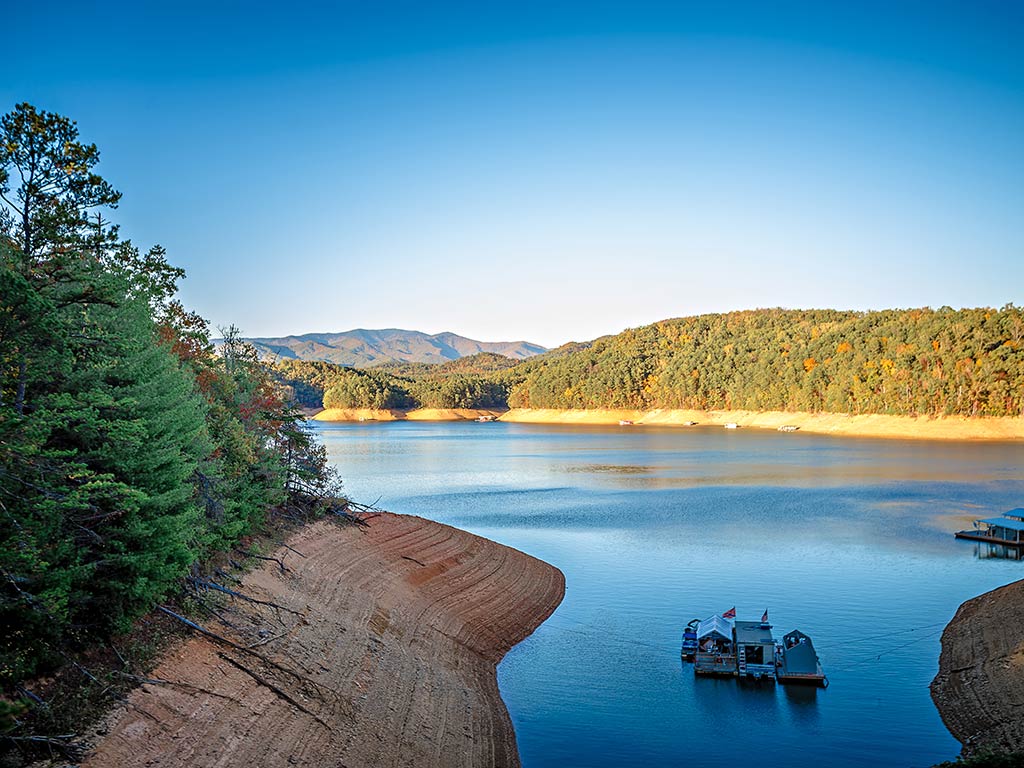
The western half of North Carolina is mountain country and comprises swift water creeks and rivers. It also boasts some of the largest reservoirs in the state. This region is best known for its fantastic Smallmouth Bass fishing. Here’s where we suggest you visit:
- French Broad River. The French Broad River, winding through the scenic landscapes of western North Carolina, boasts excellent Bass fishing. With its deep pools, swift currents, and rocky structures, this river offers abundant opportunities to catch Smallmouth Bass. That’s why it’s a favorite among fly anglers.
- Fontana Lake. Nestled among the Great Smoky Mountains, Fontana Lake presents Bass anglers with a beautiful setting for their fishing pursuits. This deep, clear lake is home to various Bass species, including Largemouth, Smallmouth, and Spotted Bass. That means opportunities for both novice and experienced anglers!
- Lake Junaluska. This 200-acre mountain lake offers a serene atmosphere for Bass fishing enthusiasts. With its calm waters, anglers can target Largemouth Bass, appreciating the tranquility of the surrounding gardens and town center.
- Nantahala Lake. Located in the famous Nantahala National Forest, Nantahala Lake provides anglers with a remote and peaceful Bass fishing experience. This deep, clear lake is home to Smallmouth and Largemouth Bass. Consider hiring a guide to navigate around this 1600-acre reservoir.
The Piedmont Region
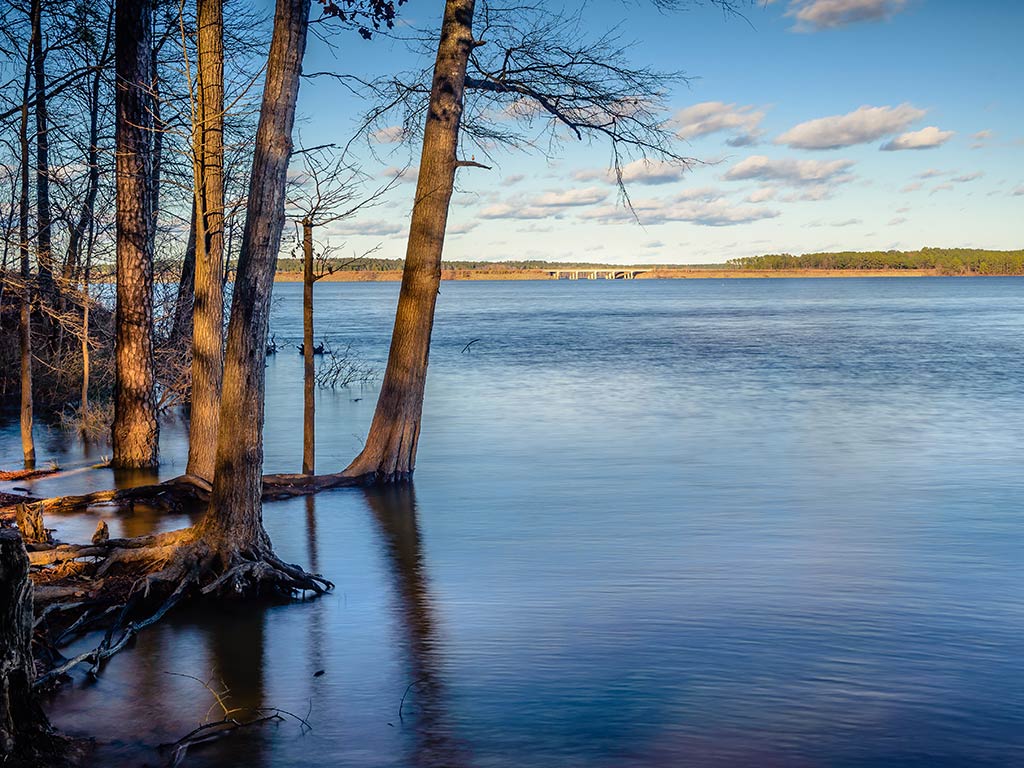
The Piedmont region is the central part of the state. Situated between the mountains in the west and the coastal plains of the east, it’s home to rolling hills that make for some delightful angling corners. Check out the following:
- High Rock Lake. A sprawling reservoir, High Rock Lake is known for its exceptional Bass fishing scene. Anglers can pursue Largemouth and Striped Bass in its clear waters, taking advantage of the lake’s diverse shoreline, submerged structures, and deep coves. A productive and exciting fishing experience is all but guaranteed.
- Lake Townsend. Located near Greensboro, Lake Townsend is a popular Bass fishing destination offering anglers abundant opportunities to catch Largemouth Bass. This lake gets substantial fishing pressure due to its proximity to Greensboro, but it still produces Bass up to 10 pounds every year.
- Jordan Lake. At 13,940 acres, Jordan Lake is one of the largest lakes in North Carolina. Renowned for its excellent Bass fishing, anglers can target both Largemouth and Striped Bass in this expansive reservoir. Look for schooling shad and Stripers feeding in open water.
Eastern North Carolina
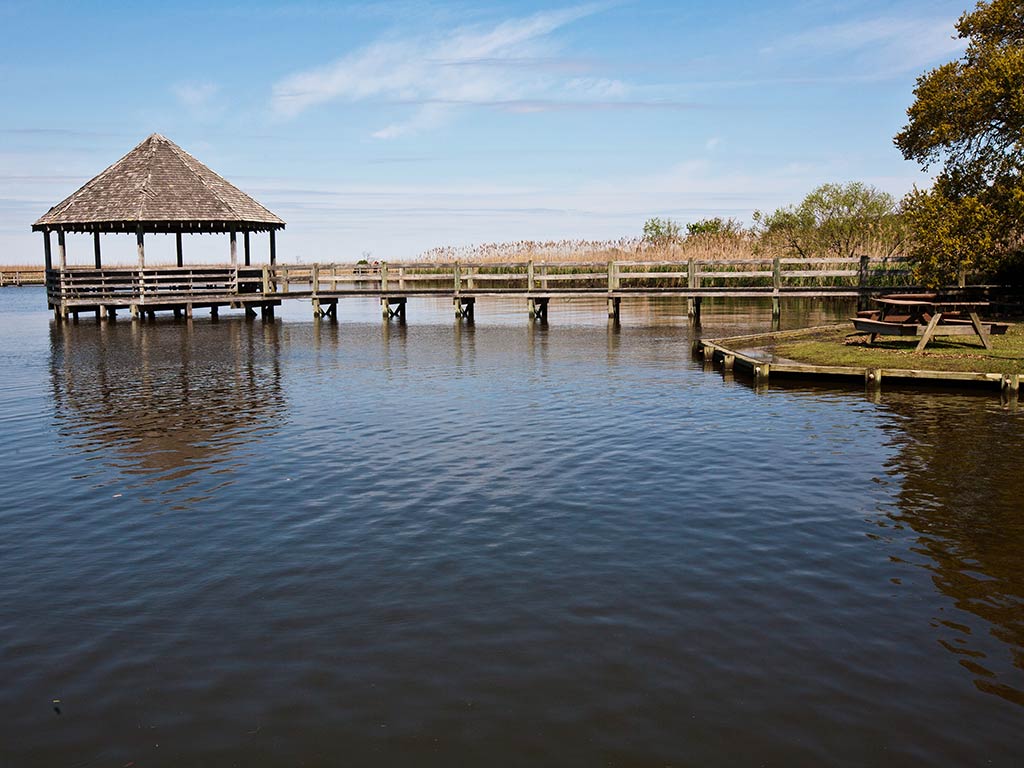
The eastern half of the state, also known as the coastal region, is comprised of blackwater rivers, lakes, and brackish sounds. All of these boast excellent Bass fishing. This region is known for its great Largemouth Bass fishing, with the following locales standing out:
- Currituck Sound. Situated along the Outer Banks, this is a brackish-water sound offering unique Bass fishing opportunities. Anglers can target Largemouth Bass in this estuarine ecosystem, where the sound’s marshes, channels, and shallow flats provide exciting challenges and the chance to reel in impressive catches. Who knows, you may even land a Redfish or Trout, too.
- Lake Mattamuskeet. The largest natural lake in North Carolina, this body of water measures a whopping 40,000 acres. It’s known for its expansive shallow freshwater habitat that attracts Bass and millions of migratory ducks and geese each year. During periods of high water, focus on the bridges and water control structures that act as pinch points for bait.
- Roanoke River. The historic Roanoke River, flowing through scenic landscapes, offers excellent Bass fishing opportunities with its habitats, including deep pools and rocky ledges. These support healthy populations of Largemouth and Smallmouth Bass, providing anglers with thrilling challenges and rewarding catches.
- Lumber River. A blackwater river surrounded by lush forests, this stream offers Bass anglers a tranquil fishing experience amidst picturesque scenery. With its slow-moving waters and hidden structures, such as fallen logs, this waterway presents opportunities to catch Largemouth Bass and plenty of Sunfish.
- Cape Fear River. Known for its vast estuarine system, the Cape Fear River creates a thriving Bass fishing environment where it meets the Atlantic Ocean. Fishing really picks up when American shad are running, so focus on using imitation shad swimbaits.
When To Go Bass Fishing in North Carolina
Like most Bass fishing destinations, the best fishing is before, during, and just after the spawning period. In North Carolina, Bass spawn once the water temperature hits 64 to 68 degrees. This typically peaks in the month of May.
In warmer regions of the state, Bass anglers will be on the water as early as March looking for bedding activity. As temperatures rise throughout April and May, the bite is excellent.
Throughout early summer, the spawning activity will gradually decline and the fish will move into a post-spawn pattern, usually feeding heavily on summer bait fish. But don’t worry, plenty of anglers find success Bass fishing in the fall and winter too. A good rule of thumb is to downsize your baits and slow your presentation anytime the water temperature drops below 50 degrees.
Popular Bass Fishing Techniques in NC
Aptly named after the region, the Carolina rig is a reliable technique and presentation that anglers use to cover water and locate pockets of fish. The rig is comprised of a worm or soft plastic, 12–18 inches of leader, and a bullet weight tied just above a swivel. This type of rig is ideal for the deep reservoirs or swift current rivers often found in North Carolina. Fish it slow or fast, and adjust your weight size to go deeper or shallower.
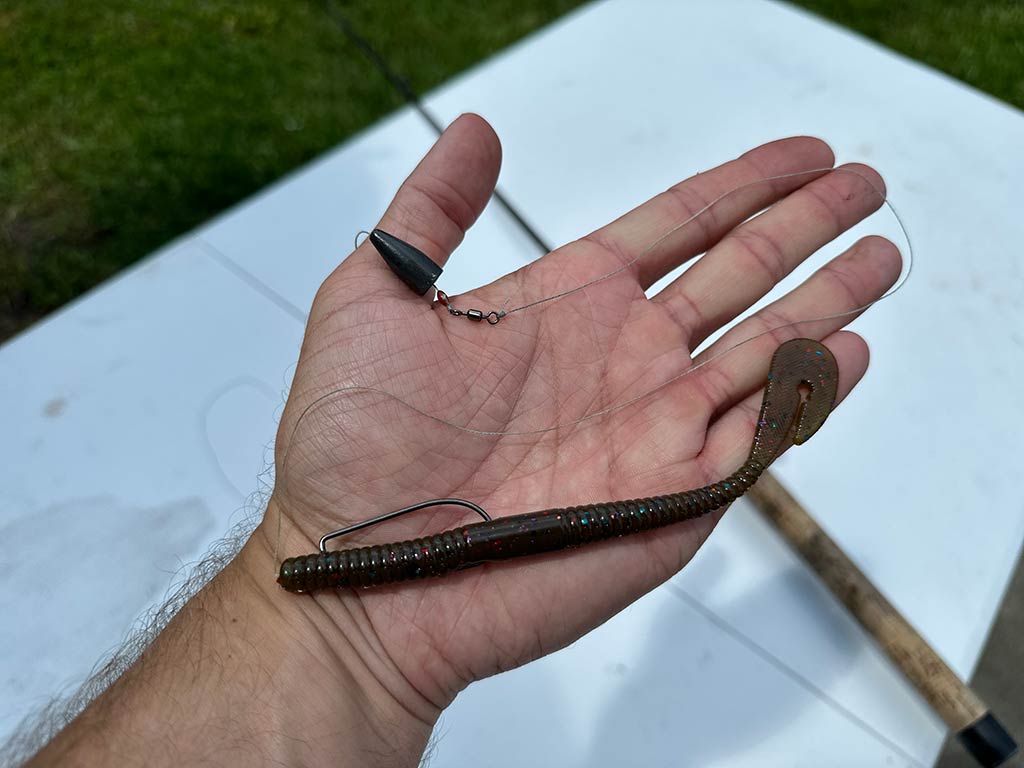
Crawfish and creature-style baits are also very popular in the Tar Heel State, mainly because so many of the lakes, rivers, and creeks contain rocky habitats, which are home to crawfish. Particularly effective in western North Carolina, crawfish and crawfish imitation lures are very popular when targeting Smallmouth Bass. And Largemouth Bass will bite them as well.
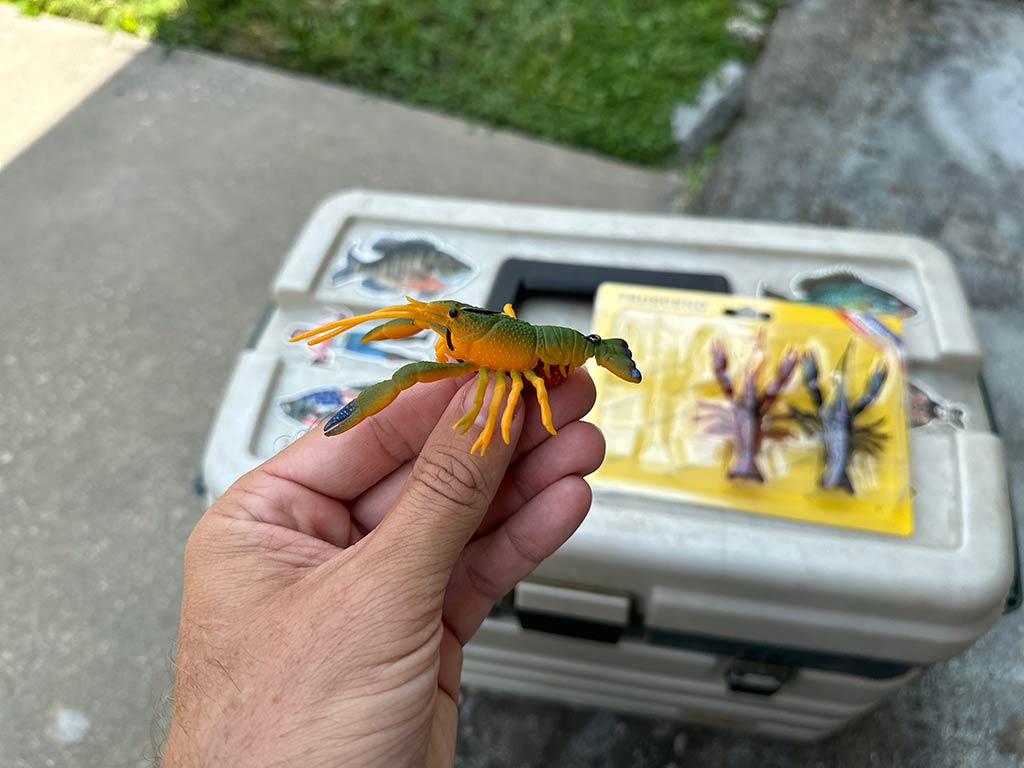
Adjust your lure selection based on the type of water body you are fishing. For example, if you’re fishing the large, deep, and clear reservoirs of the Piedmont region use baits that cover water well, such as spinnerbaits or crankbaits.
If you’re fishing more of the brackish rivers in the coastal region, fish with dark color baits that can easily get in and out of snags and aquatic vegetation. Im talking something like a weedless senko worm or drop shot rig.
North Carolina Bass Fishing Regulations
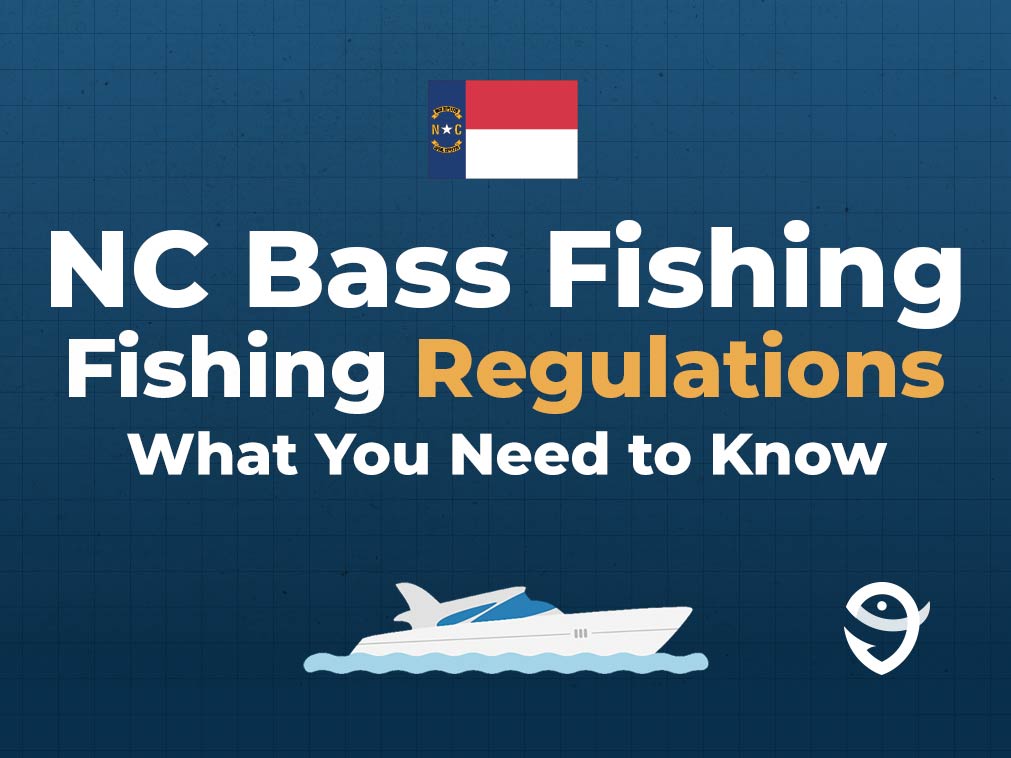
Before I let you go, there’s just some housekeeping to make sure you’re fishing within the law. First of all, every angler aged 16 years and older must have a valid fishing license when fishing in North Carolina.
You can buy 10-day or annual licenses, with costs varying depending on whether you’re an NC resident or not. Check out our handy guide for a complete breakdown of the permits you can obtain.
You should also check with the NC Wildlife Resources Commission for the latest bag and size limits. However, if you head out with a guide or charter captain, they’ll make sure you’re sticking to the rules.
North Carolina Bass Fishing: Diverse Rewards Await

North Carolina is a big state, and one of the most diverse when it comes to Bass fishing habitats and surroundings. Fish in the misty mountains of the west, or the historic coastal plains of the east… the choice is yours. At the end of the day, with Bass reaching up to 15 pounds, there’s a real chance you’ll land a trophy. Plan your fishing trip to North Carolina today – you won’t regret it!
Have you ever been Bass fishing in North Carolina? Any favorite spots or techniques you’d like to share with us? Get in touch by hitting the comment button below!
The post How to Go Bass Fishing in North Carolina: The Complete Guide appeared first on FishingBooker Blog.
https://ift.tt/cFluekU
0 Comments
Enregistrer un commentaire